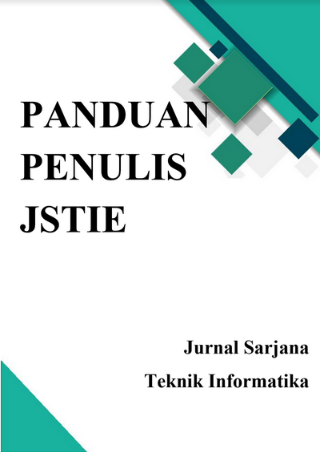Virtual Reality Tour Menggunakan Metode Gambar Panorama 360 Sebagai Media Informasi dan Pengenalan Gedung Perkuliahan Kampus 4 Universitas Ahmad Dahlan
DOI:
https://doi.org/10.12928/jstie.v1i1.19045Keywords:
Gambar panorama 360, Gedung Perkuliahan Kampus 4 UAD, Virtual TourAbstract
Mahasiswa UAD setiap tahun semakin bertambah saat ini UAD memiliki 25.239 mahasiswa dari seluruh Indonesia bahkan mancanegara, serta Keadaan di luar prediksi berupa wabah penyakit covid-19 telah membawa perubahan yang mendesak pada sektor pendidikan. Informasi terkait UAD banyak dicari oleh mahasiswa baru dan masyarakat umum namun informasi yang dapat diakses masih sangat sedikit terutama informasi yang sudah dalam bentuk visual.
Pengembangan Virtual Tour ini menggunakan metode gambar panorama 360. Gambar panorama 360 adalah beberapa gambar yang digabungkan untuk mendapatkan gambar yang lebih luas dan lebih detail. Pengembangan perangkat lunak pada Virtual Tour ini menggunakan metode Waterfall.
Hasil penelitian ini berupa aplikasi Virtual Tour sebagai media pengenalan gedung perkuliahan kampus 4 UAD. Berdasarkan hasil pengujian menggunakan Black Box didapat persentase kelayakan 100 % dapat disimpulkan bahwa aplikasi layak untuk digunakan dan hasil pengujian dengan SUS didapat skore SUS 88.775 dapat disimpulkan bahwa aplikasi berjalan dengan baik serta mudah digunakan oleh pengguna.
Kata kunci: Gambar panorama 360, Gedung Perkuliahan Kampus 4 UAD, Virtual Tour
References
Adityo, A. (2017). Pembuatan Virtual Reality Tour dengan Metode Gambar Panorama untuk Kampus Fakultas Teknik Universitas Hasanuddin TUGAS. Universitas Nusantara PGRI Kediri, 01, 1–7. Retrieved from http://www.albayan.ae
Febrian, J. (2002). Kamus Komputer dan Istilah Teknologi Informasi.
Hofstetter, F. T. (1949). Multimedia Literacy. David Kendric Brake.
Liputan6.com. (2020). Enam Kebijakan Kemendikbud dalam Masa Darurat Covid-19. Retrieved from https://www.liputan6.com/news/read/4227701/enam-kebijakan-kemendikbud-dalam-masa-darurat-covid-19
merdeka.com. (2020). Data Terkini Jumlah Korban Virus Corona di Indonesia. Retrieved from https://www.merdeka.com/peristiwa/data-terkini-jumlah-korban-virus-corona-di-indonesia.html
Putro, H. T. (2015). Kajian Virtual Reality Makalah Studi Mandiri Kajian Virtual Reality Program Studi Teknik Arsitektur dan Perencanaan Oleh Pembimbing : Ir . Jatmika Adi Suryabrata ., MSc ., Ph . D . (January).
Tabrani, M., & Pudjiarti, E. (2017). Penerapan Metode Waterfall Pada Sistem Informasi Inventori Pt. Pangan Sehat Sejahtera. Jurnal Inkofar, 1.
Trieddiantoro Putro, H. (2015). Kajian Virtual Reality. Kajian Virtual Reality.
Uad.ac.id. (2019). Mahasiswa UAD. Retrieved from https://uad.ac.id/en/#students
Yuda Pramana, G. (2019). Penerapan metode image stitching pada pembuatan virtual reality pengenalan islamic center universitas ahmad dahlan. xx, 1–8.
Yulianto, D. A. (2012). Pemodelan Virtual Reality Sebagai Media Promosi Digital.
Downloads
Published
Issue
Section
License
License and Copyright Agreement
In submitting the manuscript to the journal, the authors certify that:
- They are authorized by their co-authors to enter into these arrangements.
- The work described has not been formally published before, except in the form of an abstract or as part of a published lecture, review, thesis, or overlay journal. Please also carefully read Journal Posting Your Article Policy.
- The work is not under consideration for publication elsewhere.
- The work has been approved by all the author(s) and by the responsible authorities – tacitly or explicitly – of the institutes where the work has been carried out.
- They secure the right to reproduce any material that has already been published or copyrighted elsewhere.
- They agree to the following license and copyright agreement.
Copyright
Authors who publish with Jurnal Sarjana Teknik Informatika agree to the following terms:
- Authors retain copyright and grant the journal right of first publication with the work simultaneously licensed under a Creative Commons Attribution License (CC BY-SA 4.0) that allows others to share the work with an acknowledgement of the work's authorship and initial publication in this journal.
- Authors are able to enter into separate, additional contractual arrangements for the non-exclusive distribution of the journal's published version of the work (e.g., post it to an institutional repository or publish it in a book), with an acknowledgement of its initial publication in this journal.
- Authors are permitted and encouraged to post their work online (e.g., in institutional repositories or on their website) prior to and during the submission process, as it can lead to productive exchanges, as well as earlier and greater citation of published work.








